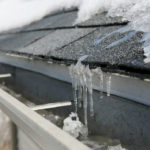
What is the Standard Gutter Size?
Installing a gutter system is one of the best ways to shield your home’s foundation from the devastating impact of rainfall and snowfall. A gutter system helps move rainwater from your roof and away from your foundation.
If rainwater isn’t properly drained away from your home, it can cause foundation cracking and settling and water damage to the siding, doors, and windows. It can also result in oversaturation of lawns and flower beds, soil erosion, and other costly problems.
When buying gutters, selecting the right size for your location and home is vital. If you buy too small gutters, they’ll overflow. If you buy a size that’s too large, you run the risk of rainwater standing still instead of flowing toward the downspouts.
We’ve created this guide to standard gutter sizes to help homeowners understand what gutter sizes they should install. After reading this, we’re hoping you’ll be able to buy the correct gutter size for your home based on your area’s climate and location.
What’s the Significance of Gutter Size?

Gutters are typically available in three standard sizes: 4, 5, and 6 inches. They collect rainwater and safely direct it away from your property. Regardless of the intensity of the rainstorm, a quality gutter system will efficiently prevent the formation of water pools around your home’s foundation and landscape.
But if you need the right size and type of gutters installed, you may have to shoulder costly structural problems that might compromise your home’s overall stability. A slight mistake during gutter installation can make it ineffective.
If your gutters are too narrow, they’ll overflow even with moderate rainfall, especially if you receive multiple successive rainy days. Undersized gutters also contribute to roof damage, frequent clogs, ice dams, damp foundations, and a generally ruined landscape.
This doesn’t mean that too wide gutters are always the better option, and they’re unsightly to look at and cost much more.
Standard Gutter Sizes
Generally, gutters are available in a couple of standard widths: 5 inches or 6 inches. Regarding half-round gutters, 6-inch ones are the best size for handling extreme weather conditions. But in drier climates, 5-inch half-round gutters are the standard size.
The most popular size of K-style gutters is 5 inches wide, and this is because this gutter style has a deeper trough that can handle heavy rain and snowfall, especially when combined with gutter guards. A better choice in areas that receive heavier than the average rainfall could be 6-inch K-style gutters.
Multiple factors may affect a gutter system’s performance, however. Sometimes, homeowners may wish to install bespoke oversized gutters to ensure water properly drains off the roof without overflowing the trough.
Several factors determine the gutters you need for your home, including your roofline’s overall size, your roof design, your roof’s pitch of steepness, and your area’s maximum rainfall density.
While wider gutters cost a little extra, they are better equipped to satisfy your home’s needs.
Gutter Thickness
Apart from the width, gutter thickness is another crucial consideration when it comes to gutter sizes. Also referred to as the gutter gauge, the thickness of the gutter material determines its performance in harsh weather conditions.
Generally speaking, the thicker the gutter material, the better it’ll hold up in extreme weather. The right gutter thickness for your house will depend on your area’s rainfall density and the gutter material.
Aluminum
This is, by a mile, the most common gutter material. Aluminum’s gauge is measured in thousandths of an inch. The standard thickness of an aluminum gutter is 0.27 inches, which is usually enough to hold out mild to moderate rainfall and weather conditions. But if your area is prone to extreme weather, like heavy snowfall or hurricanes, a thicker 0.32-inch gutter might be a better fit.
Steel
Steel is a sturdy gutter material with thickness in the range of 24 to 30 gauge. In America, the most common steel gutters are 26 gauge. To protect your house from snow and rain buildup, it’s better to go thicker by opting for a 24-gauge steel gutter. In drier areas, a 30-gauge gutter is the better option.
Copper

Less common than other gutter materials, many homeowners choose copper gutters because they withstand harsh weather well over time. The most common copper gutters are 20-gauge, but you can also go for other options like 16-gauge and 24-gauge. However, a higher figure denotes a thinner gutter with copper gutters.
Vinyl
Made with standard PVC plastic, vinyl gutters can be an excellent, inexpensive choice in temperate climates without sub-freezing temperatures or extremely wet weather. If you opt for vinyl gutters, consult a professional to ensure the thickness of the plastic can handle your area’s climate.
What Size of Gutters Does Your Home Need?
While 5 and 6 inches are the industry standard for gutter size, several factors determine what gutter size you should buy for your home.
- Roof size: The larger your roof, the larger your gutters need to be.
- Maximum rainfall intensity: The more rainfall your area receives, the larger should be your gutter system.
- Slope: The steepness of your roof will determine how quickly rainwater will run off. Therefore, more oversized gutters are recommended for steeper roofs.
- Gutter drainage area: The larger the square footage of your gutter’s drainage area, the larger your gutter system needs to be.
When determining the perfect gutter size for your home, you must also consider the size of your downspouts.
As with gutters, the capacity of your downspouts should match the potential runoff from your roof. If you’ve got a 5-inch K-style gutter, you should buy 3×4 “or 2×3 “downspouts. It would help to place downspouts at the proper distance, for example, every 20 to 40 feet.
Contact a Local Roofing Contractor Today
Installing the right size of quality gutters is one of the most foolproof ways to prevent water damage in your home. On the other hand, the wrong size of gutters can cause wet ceilings, rotten roof sheathing, and flooded basements.
Gutter installation is a complex project that requires professional roofing services. If you want to install a new gutter system in your home, find a qualified, licensed, and experienced roofing contractor in your area. You can do so by comparing quotes from three to four local contractors.



